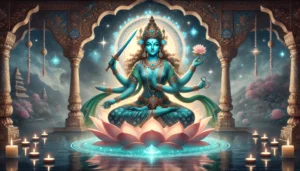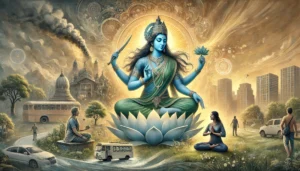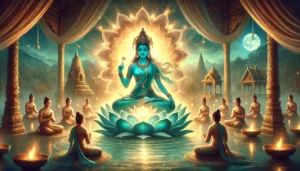Power of Goddess Tara Devi: Protector and Compassionate
Tara Devi: The Compassionate Goddess of Protection and Guidance in the Dasha Maha Vidyas
Tara Devi, the Goddess of Protection and Compassion in the Dasha Maha Vidyas
Introduction
Tara, one of the ten Mahavidyas in Hinduism, is a powerful goddess known for her protective and compassionate nature. Her energy is fierce yet nurturing, guiding devotees through the challenges of life and helping them transcend fear and ignorance. For centuries, Tara Devi has been worshipped as a divine protector, a guide through life’s storms, and a source of immense spiritual wisdom. This article delves into the role of Tara Devi in the Dasha Maha Vidyas, compares her with Kali, explores tantric practices like Tara Devi Sadhana, and outlines the benefits devotees can gain from invoking her energy.
Who Is Goddess Tara Devi?
A Compassionate Savior in the Dasha Maha Vidyas

Tara Devi is revered as a goddess of protection, wisdom, and compassion, and is known for her ability to guide devotees through times of difficulty. Her name, which translates to “star” or “one who ferries across,” highlights her role as a beacon of light, showing the way through the darkness of ignorance, fear, and confusion. Tara Devi is often associated with saving devotees from both external dangers and internal suffering.
Her energy is particularly beneficial for those experiencing life transitions, whether spiritual, emotional, or material. Unlike deities associated with pure destruction or wrath, Tara Devi balances ferocity with maternal compassion. She is the one who fiercely protects her devotees, guiding them through the unknown and ensuring their safe passage to spiritual realization.
Mythological Origins of Tara Devi
The origins of Tara Devi can be traced to both Hinduism and Buddhism, where she is celebrated for her role as a compassionate guide. In Hinduism, she is recognized as a form of Shakti, the divine feminine energy, embodying protection and wisdom. In the Buddhist tradition, Tara Devi is perhaps even more prominent, revered as a bodhisattva who delays her enlightenment to assist all beings on their spiritual journey. Both traditions depict her as a goddess of immense grace, love, and mercy.
In Hindu mythology, Tara Devi is one of the Dasha Maha Vidyas—the ten forms of the Divine Mother—each representing different aspects of life and the cosmos. Tara, in particular, governs the energy of overcoming difficulties and transcending fear.
Depictions and Iconography of Tara
Tara Devi iconography is rich with symbolism. She is typically depicted with blue or green skin, reflecting her connection with the vast, boundless energy of the sky and the oceans—both of which signify the limitless nature of her compassion. In her hands, she often holds weapons like a sword, used to cut through the knots of ignorance and attachment, and sometimes a pair of scissors, symbolizing her power to sever the ties that bind her devotees to worldly delusion.
In some depictions, she is shown seated on a lotus, symbolizing purity and spiritual awakening. Her third eye represents her wisdom and ability to see beyond illusion. Tara Devi’s expression may be fierce, but her energy is always maternal, caring, and protective.
Tara vs. Kali: Two Faces of Fierce Compassion

Kali: The Goddess of Destruction
Kali, another powerful goddess in the Dasha Maha Vidyas, is often worshipped for her transformative energy. She is the force of time and death, the destroyer of illusion, and the fierce remover of ego. Kali’s energy is intense, direct, and focused on annihilation to facilitate spiritual growth. When invoked, she shatters the illusions of the material world, severing attachments and paving the way for spiritual rebirth.
Kali’s form is terrifying, with a garland of skulls, a protruding tongue, and a dark, fearsome visage. However, her destruction is not malevolent; it is essential for the transformation and liberation of the soul. Her energy is often best suited for those who are ready to face the raw truth of existence and their egoic attachments.
Tara: The Protector and Guide
While Kali focuses on destruction, Tara Devi’s role is more about guiding devotees safely through the chaos that Kali brings. Tara provides a gentler yet equally powerful form of fierce compassion. Where Kali cuts ties with the material world without hesitation, Tara offers a guiding hand, ensuring that her devotees are not lost in the transformative process. Tara Devi’s energy is centered on protection and nurturance, making her especially appealing to those who feel vulnerable in the face of change and uncertainty.
Tara is the light that shines in the darkest moments, helping her followers navigate their fears and challenges. In times of deep crisis, whether external or internal, Tara Devi’s presence can provide clarity, wisdom, and inner strength.
The Symbiotic Relationship Between Kali and Tara
The energies of Kali and Tara are not oppositional but rather complementary. Kali, the force of destruction, clears the path by removing obstacles, illusions, and attachments. Tara, on the other hand, ensures that the journey through this path is safe and that spiritual growth is achieved without unnecessary suffering. Kali is the initiator of change, while Tara acts as the guide and protector during the transformation.
In tantric practices, these two goddesses are often invoked together, as their energies work in tandem to help the devotee experience both destruction and protection—clearing the old and guiding the devotee toward new spiritual heights. Together, they offer a balance of fierce transformation and compassionate guidance.
Major Temples Dedicated to Goddess Tara in India

Tara Tarini Temple, Odisha
Located on the Kumari Hills in Odisha, the Tara Tarini Temple is one of the oldest Shakti Peethas in India. It is believed to be a place where the breasts of Goddess Sati, the first wife of Lord Shiva, fell, making it a highly sacred site. As one of the four major Shakti Peethas, the Tara Tarini Temple attracts thousands of devotees seeking protection, strength, and guidance.
Perched atop a hill, the journey to the temple itself is considered an act of devotion, with many devotees climbing the hill on foot as a form of penance. The temple’s energy is believed to be especially potent during the Chaitra Mela, a festival held in the Hindu month of Chaitra (March-April). Devotees who visit this temple often seek Tara Devi blessings for protection, strength, and the removal of obstacles in their lives.
Neel Saraswati Tara Temple, Varanasi
The Neel Saraswati Tara Temple in Varanasi is dedicated to a blue-skinned form of Tara, known as Neel Saraswati. Unlike the more commonly known white Saraswati, the goddess of learning, Neel Saraswati is a fierce form associated with wisdom and tantric practices. This temple is especially revered by tantric practitioners, as it is believed that Tara, in her Neel Saraswati form, can help devotees overcome ignorance and gain profound spiritual knowledge.
Though small in size, the temple’s spiritual significance is immense. It is a place where seekers come to invoke Tara for wisdom, guidance, and liberation. For those interested in tantric practices, this temple holds special importance as a gateway to deeper spiritual understanding.
Tara Devi Temple, Himachal Pradesh
Located in the lush hills of Shimla, Himachal Pradesh, the Tara Devi Temple is a serene and powerful site of worship. Tara is revered here as a goddess of protection, and the temple’s peaceful surroundings make it an ideal location for deep meditation and sadhana. This temple is also a popular pilgrimage destination for those seeking inner strength and spiritual clarity.
The temple’s location amidst the natural beauty of the hills adds to its spiritual ambiance, making it a favorite destination for devotees looking to connect deeply with the energy of Tara.
The Role of Tara Devi in Tantric Practices

Tara in Tantric Tradition: A Goddess for Spiritual Seekers
In the tantric tradition, Tara is considered one of the most important goddesses for those pursuing spiritual growth. As a Mahavidya (Great Wisdom), her role in tantra is not limited to offering protection from external forces. More significantly, Tara provides protection from the inner demons of fear, doubt, and ignorance that hinder spiritual progress. She is revered as a goddess who not only protects but also illuminates the path toward ultimate knowledge and liberation.
The Power of Tara Sadhana
Tara Sadhana is a deeply spiritual practice aimed at invoking the goddess’s energy for protection, wisdom, and the removal of obstacles. This sadhana can be simple or highly advanced, depending on the practitioner’s level of experience. It typically involves chanting her sacred mantra, meditation, and performing rituals designed to awaken her energy within the practitioner.
One of the key elements of Tara Sadhana is the visualization of the goddess, either in her fierce protective form or as a compassionate mother. Through meditation and mantra repetition, devotees can connect with Tara Devi’s divine energy, invoking her protection and guidance in their daily lives.
The Tara Mantra: A Sacred Invocation
The Tara Mantra is one of the most powerful tools in Tara Sadhana. The mantra, “Om Tare Tuttare Ture Swaha,” is a sacred chant that invokes the energy of the goddess for protection, wisdom, and spiritual liberation. Each syllable of the mantra is packed with deep spiritual meaning:
- Tare: Calls upon Tara for liberation from physical suffering.
- Tuttare: Removes inner and outer obstacles such as fear, ignorance, and confusion.
- Ture: Invokes Tara Devi protection from spiritual dangers and negative energies.
- Swaha: Offers oneself to Tara, signifying complete surrender to her divine will.
Chanting this mantra with devotion and focus can bring about profound spiritual transformation. It is often recited hundreds or thousands of times during a sadhana to build a strong connection with the goddess.
Advanced Rituals: Yantra and Homa Practices
In addition to mantra chanting, advanced Tara Sadhana practices may include the use of yantras and homas (fire rituals). A yantra is a sacred geometric diagram that acts as a tool for focusing divine energy. The Tara Yantra is a powerful aid in meditation, helping practitioners to connect more deeply with the goddess’s energy.
Homas, or fire sacrifices, are another integral part of advanced tantric rituals. In these rituals, offerings such as ghee, grains, and herbs are poured into a sacred fire while chanting the Tara mantra. The fire symbolizes transformation, and the ritual offerings represent the devotee’s symbolic surrender of ego, desires, and attachments to the goddess.
Where and How Tara Sadhana Is Performed
Tara Sadhana can be performed in various settings, from large temples to small home altars. However, due to the complexity of some of the tantric rituals, it is highly recommended that the sadhana be performed under the guidance of a qualified guru or tantric teacher. The guru helps the devotee understand the deeper meaning behind the rituals, ensuring they are performed correctly.
In-home settings, devotees may create a small altar dedicated to Tara, complete with images of the goddess, a Tara Yantra, and offerings like flowers, incense, and fruits. Chanting the mantra regularly in front of this altar can create a powerful connection with the goddess.
Outcomes of Tara Devi Sadhana: What Devotees Can Expect

Wisdom and Inner Strength
One of the primary outcomes of practicing Tara Sadhana is the acquisition of wisdom. Tara Devi’s energy clears away ignorance and illusion, allowing the devotee to see the truth more clearly. She provides insight into the nature of reality, helping practitioners make wise decisions both in their spiritual life and in the material world.
Along with wisdom, devotees often find that they develop inner strength—the courage to face life’s challenges without fear. Tara empowers her followers, giving them the confidence and resilience needed to overcome obstacles.
Overcoming Fear and Ignorance
Fear is one of the most significant obstacles on the spiritual path. Whether it is fear of death, failure, or the unknown, Tara Devi’s energy works to remove these fears from the hearts of her devotees. Through the consistent practice of Tara Sadhana, practitioners find themselves freed from the bondage of fear, allowing them to move forward on their spiritual journey with confidence.
Tara also helps in overcoming ignorance, which is seen in tantric teachings as the root of all suffering. By illuminating the mind with her wisdom, Tara helps devotees break free from the illusions that cause pain and confusion.
Liberation from Suffering (Moksha)
The ultimate goal of Tara Sadhana is moksha—liberation from the cycle of birth, death, and rebirth. Tara, as the compassionate savior, guides her devotees toward spiritual freedom. For those who practice with dedication and sincerity, Tara Devi’s blessings extend beyond protection and wisdom, leading to the ultimate liberation of the soul.
Famous Stories of Devotees Saved by Tara

Tara Devi’s Role in the Story of Vashishtha
One of the most well-known stories of Tara Devi’s intervention is that of the sage Vashishtha. According to Hindu mythology, Vashishtha was once trapped in the turbulent waters of Samsara, the endless cycle of birth and death. It was Tara who appeared and saved him from drowning, guiding him safely to the shores of spiritual wisdom.
This story is symbolic of Tara Devi’s role as a protector and guide, particularly in moments of great spiritual confusion or danger. Just as she saved Vashishtha, Tara can save her devotees from the ocean of worldly suffering, leading them toward enlightenment.
The Power of Tara in Buddhist Traditions
In Tibetan Buddhism, Tara holds a similar role as a goddess of protection and compassion. She is considered a bodhisattva who has vowed to remain in the cycle of rebirth until all beings are liberated. Stories of monks and practitioners being saved by Tara Devi’s intervention abound in Buddhist texts. She is known for her swift action, coming to the aid of those who call upon her with sincere devotion.
Why Tara Devi Is Relevant in Modern Times

Protection and Guidance in Times of Crisis
In today’s fast-paced, uncertain world, Tara Devi’s energy is perhaps more relevant than ever. Whether facing personal crises or global challenges, people are increasingly turning to spiritual practices for support, guidance, and protection. Tara Devi’s compassionate yet fierce energy can provide a sense of calm, clarity, and courage in times of upheaval.
Many devotees who connect with Tara feel a profound sense of peace and protection, knowing that they are being guided and safeguarded by her divine energy. Her role as a compassionate savior makes her a powerful ally in navigating the challenges of modern life.
The Feminine Energy of Nurturance and Empowerment
As the world becomes more aware of the need for feminine energy to balance the often destructive forces of masculinity, Tara Devi’s presence becomes increasingly important. She offers a blend of fierce protection and nurturing care, empowering her devotees while also providing comfort and safety. Her divine feminine energy is a reminder of the strength that comes from compassion, wisdom, and inner peace.
How to Connect with Goddess Tara: Practical Steps

Starting a Simple Tara Worship Practice
For beginners, connecting with Goddess Tara can start with a simple worship practice. Devotees can set up a small altar with a picture or statue of Tara, light a lamp or candle, and offer flowers or incense. Regular recitation of the Tara mantra, even for just a few minutes each day, can build a strong connection with her energy.
Visiting Tara Temples: A Spiritual Pilgrimage
For those who wish to deepen their connection with Tara, visiting one of her sacred temples can be a transformative experience. Temples such as the Tara Tarini Temple in Odisha or the Neel Saraswati Tara Temple in Varanasi are imbued with the goddess’s energy, making them ideal locations for spiritual retreats and meditation.
A pilgrimage to one of these temples allows devotees to physically and spiritually immerse themselves in Tara Devi’s energy. Such a journey is often seen as a powerful way to seek the goddess’s blessings and guidance.
Seeking Guidance from a Guru
For those interested in the more advanced practices of Tara Sadhana, it is crucial to seek the guidance of a guru. Tantric practices require deep understanding and precision, and a qualified teacher can provide the necessary spiritual support and instruction to ensure that the rituals are performed correctly.
A guru not only teaches the mechanics of the rituals but also helps the devotee navigate the spiritual challenges that arise on the path. With proper guidance, devotees can safely access the deeper dimensions of Tara Devi energy.
Embrace Tara Devi Energy for Protection and Spiritual Liberation

Goddess Tara, the compassionate savior and protector, holds a unique place in both Hindu and Buddhist traditions. Her energy is both fierce and nurturing, offering devotees protection from external dangers and internal fears. Through practices like Tara Sadhana, visiting her sacred temples, or simply reciting her mantra, devotees can access her transformative power. Whether one seeks wisdom, inner strength, or liberation from suffering, Tara offers her divine blessings, guiding her followers toward spiritual awakening and ultimate freedom.
Frequently Asked Questions (FAQ)
1. What is the significance of Goddess Tara in Hinduism?
In Hinduism, Tara is one of the ten Mahavidyas, representing protection, wisdom, and compassion. She is revered as a goddess who guides devotees through challenges and helps them transcend fear and ignorance.
2. How is Tara different from Kali?
While both goddesses have fierce forms, Tara Devi’s energy is more focused on protection and guidance, whereas Kali’s energy is primarily associated with destruction and transformation. Tara provides a more nurturing and maternal presence compared to Kali’s intense, destructive force.
3. What is Tara Sadhana, and how is it practiced?
Tara Sadhana is a tantric practice that involves chanting the Tara Devi mantra, meditating on her form, and performing rituals to invoke her protection and guidance. It can be performed under the guidance of a guru or in a simple form at home.
4. What are the benefits of practicing Tara Sadhana?
The practice of Tara Sadhana can bring wisdom, inner strength, protection from dangers, and liberation from fear and ignorance. Ultimately, devotees seek spiritual liberation (moksha) through Tara Devi’s guidance.
5. Can I visit a temple dedicated to Tara?
Yes, several temples in India are dedicated to Goddess Tara, including the Tara Tarini Temple in Odisha, the Neel Saraswati Tara Temple in Varanasi, and the Tara Devi Temple in Himachal Pradesh. These temples are powerful places to seek Tara Devi’s blessings.
6. Is Tara worshipped in Buddhism as well?
Yes, Tara is a central figure in Tibetan Buddhism. She is worshipped as a bodhisattva of compassion who helps devotees overcome obstacles and attain enlightenment.


















